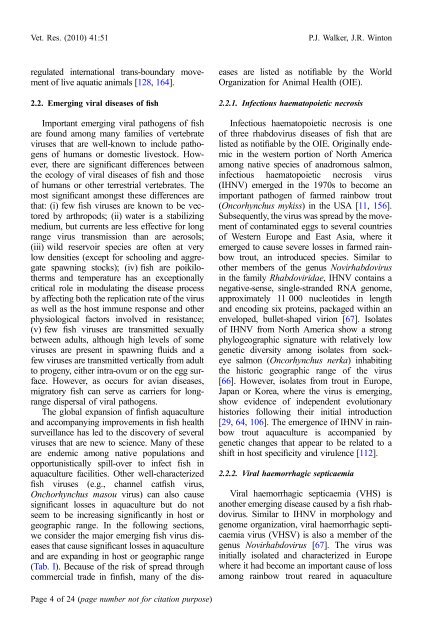Emerging viral diseases of fish and shrimp - Watershed Watch ...
Emerging viral diseases of fish and shrimp - Watershed Watch ...
Emerging viral diseases of fish and shrimp - Watershed Watch ...
Create successful ePaper yourself
Turn your PDF publications into a flip-book with our unique Google optimized e-Paper software.
Vet. Res. (2010) 41:51<br />
P.J. Walker, J.R. Winton<br />
regulated international trans-boundary movement<br />
<strong>of</strong> live aquatic animals [128, 164].<br />
2.2. <strong>Emerging</strong> <strong>viral</strong> <strong>diseases</strong> <strong>of</strong> <strong>fish</strong><br />
Important emerging <strong>viral</strong> pathogens <strong>of</strong> <strong>fish</strong><br />
are found among many families <strong>of</strong> vertebrate<br />
viruses that are well-known to include pathogens<br />
<strong>of</strong> humans or domestic livestock. However,<br />
there are significant differences between<br />
the ecology <strong>of</strong> <strong>viral</strong> <strong>diseases</strong> <strong>of</strong> <strong>fish</strong> <strong>and</strong> those<br />
<strong>of</strong> humans or other terrestrial vertebrates. The<br />
most significant amongst these differences are<br />
that: (i) few <strong>fish</strong> viruses are known to be vectored<br />
by arthropods; (ii) water is a stabilizing<br />
medium, but currents are less effective for long<br />
range virus transmission than are aerosols;<br />
(iii) wild reservoir species are <strong>of</strong>ten at very<br />
low densities (except for schooling <strong>and</strong> aggregate<br />
spawning stocks); (iv) <strong>fish</strong> are poikilotherms<br />
<strong>and</strong> temperature has an exceptionally<br />
critical role in modulating the disease process<br />
by affecting both the replication rate <strong>of</strong> the virus<br />
as well as the host immune response <strong>and</strong> other<br />
physiological factors involved in resistance;<br />
(v) few <strong>fish</strong> viruses are transmitted sexually<br />
between adults, although high levels <strong>of</strong> some<br />
viruses are present in spawning fluids <strong>and</strong> a<br />
few viruses are transmitted vertically from adult<br />
to progeny, either intra-ovum or on the egg surface.<br />
However, as occurs for avian <strong>diseases</strong>,<br />
migratory <strong>fish</strong> can serve as carriers for longrange<br />
dispersal <strong>of</strong> <strong>viral</strong> pathogens.<br />
The global expansion <strong>of</strong> fin<strong>fish</strong> aquaculture<br />
<strong>and</strong> accompanying improvements in <strong>fish</strong> health<br />
surveillance has led to the discovery <strong>of</strong> several<br />
viruses that are new to science. Many <strong>of</strong> these<br />
are endemic among native populations <strong>and</strong><br />
opportunistically spill-over to infect <strong>fish</strong> in<br />
aquaculture facilities. Other well-characterized<br />
<strong>fish</strong> viruses (e.g., channel cat<strong>fish</strong> virus,<br />
Onchorhynchus masou virus) can also cause<br />
significant losses in aquaculture but do not<br />
seem to be increasing significantly in host or<br />
geographic range. In the following sections,<br />
we consider the major emerging <strong>fish</strong> virus <strong>diseases</strong><br />
that cause significant losses in aquaculture<br />
<strong>and</strong> are exp<strong>and</strong>ing in host or geographic range<br />
(Tab. I). Because <strong>of</strong> the risk <strong>of</strong> spread through<br />
commercial trade in fin<strong>fish</strong>, many <strong>of</strong> the <strong>diseases</strong><br />
are listed as notifiable by the World<br />
Organization for Animal Health (OIE).<br />
2.2.1. Infectious haematopoietic necrosis<br />
Infectious haematopoietic necrosis is one<br />
<strong>of</strong> three rhabdovirus <strong>diseases</strong> <strong>of</strong> <strong>fish</strong> that are<br />
listed as notifiable by the OIE. Originally endemicinthewesternportion<strong>of</strong>NorthAmerica<br />
among native species <strong>of</strong> anadromous salmon,<br />
infectious haematopoietic necrosis virus<br />
(IHNV) emerged in the 1970s to become an<br />
important pathogen <strong>of</strong> farmed rainbow trout<br />
(Oncorhynchus mykiss) intheUSA[11, 156].<br />
Subsequently, the virus was spread by the movement<br />
<strong>of</strong> contaminated eggs to several countries<br />
<strong>of</strong> Western Europe <strong>and</strong> East Asia, where it<br />
emerged to cause severe losses in farmed rainbow<br />
trout, an introduced species. Similar to<br />
other members <strong>of</strong> the genus Novirhabdovirus<br />
in the family Rhabdoviridae, IHNVcontainsa<br />
negative-sense, single-str<strong>and</strong>ed RNA genome,<br />
approximately 11 000 nucleotides in length<br />
<strong>and</strong> encoding six proteins, packaged within an<br />
enveloped, bullet-shaped virion [67]. Isolates<br />
<strong>of</strong> IHNV from North America show a strong<br />
phylogeographic signature with relatively low<br />
genetic diversity among isolates from sockeye<br />
salmon (Oncorhynchus nerka) inhabiting<br />
the historic geographic range <strong>of</strong> the virus<br />
[66]. However, isolates from trout in Europe,<br />
Japan or Korea, where the virus is emerging,<br />
show evidence <strong>of</strong> independent evolutionary<br />
histories following their initial introduction<br />
[29, 64, 106]. The emergence <strong>of</strong> IHNV in rainbow<br />
trout aquaculture is accompanied by<br />
genetic changes that appear to be related to a<br />
shift in host specificity <strong>and</strong> virulence [112].<br />
2.2.2. Viral haemorrhagic septicaemia<br />
Viral haemorrhagic septicaemia (VHS) is<br />
another emerging disease caused by a <strong>fish</strong> rhabdovirus.<br />
Similar to IHNV in morphology <strong>and</strong><br />
genome organization, <strong>viral</strong> haemorrhagic septicaemia<br />
virus (VHSV) is also a member <strong>of</strong> the<br />
genus Novirhabdovirus [67]. The virus was<br />
initially isolated <strong>and</strong> characterized in Europe<br />
where it had become an important cause <strong>of</strong> loss<br />
among rainbow trout reared in aquaculture<br />
Page 4 <strong>of</strong> 24 (page number not for citation purpose)
















